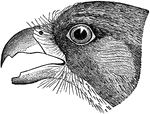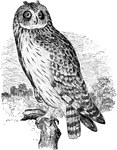Clipart tagged: ‘diurnal birds’

American Goldfinch
"Astragalinus tristis. American Goldfinch. Yellow-bird. Thistle-bird. In summer: Rich yellow, changing…

Harrier Ear Parts
"Circinae. Harriers. Face surrounded with an incomplete ruff (as in most owls); orifice of ear about…

Sparrow Hawk
"Falco sparverius. Rusty-crowned Falcon. Sparrow Hawk. Adults: Crown ashy-blue, with a chestnut patch,…

Common Kestral
Falco tinnunculus. Common Kestral. This bird is a European bird of prey. Plumage on upperside, chestnut-brown…

Osprey
An Osprey catching a fish. "Pandion haliaetus. Fish Hawk. Osprey. Adult. dark vandyke- brown, blackening…

Short-eared Owl
"Asio accipitrinus. Short-eared Owl. Marsh Owl. Ear-tufts inconspicuous, much shorter than middle toe…